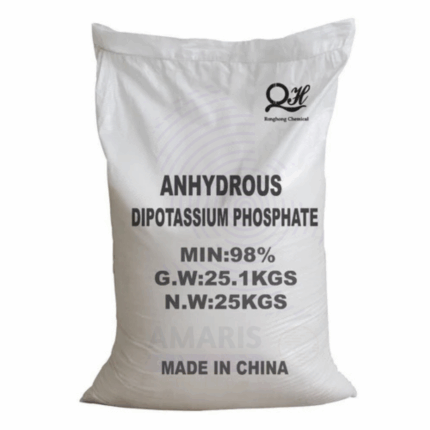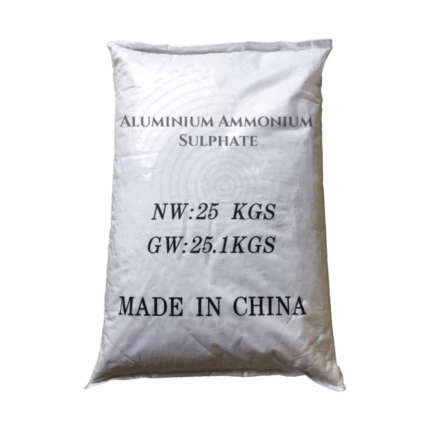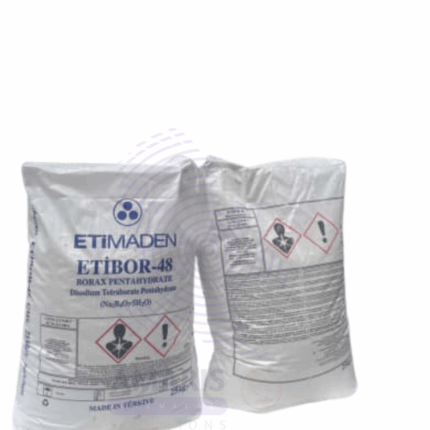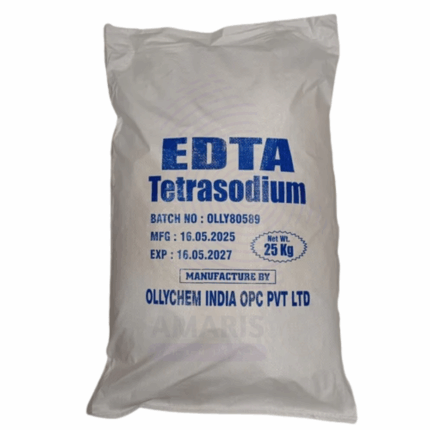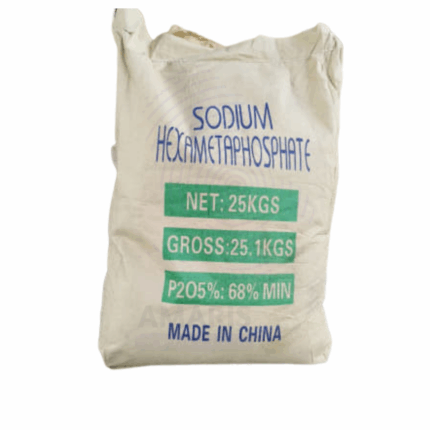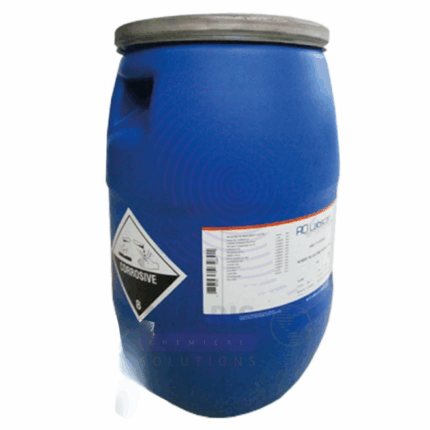
Disodium EDTA
Disodium EDTA (Ethylenediaminetetraacetic acid disodium salt) is a white, odorless, crystalline powder known for its strong chelating properties. With a purity of 99%, it is widely used across numerous industries to bind metal ions, improve stability, and enhance performance in formulations. Disodium EDTA is highly soluble in water, slightly acidic to neutral in solution, and stable under standard storage conditions. Its ability to sequester metal ions like calcium, magnesium, and iron makes it a critical additive in food, pharmaceuticals, cosmetics, water treatment, and industrial applications.
Disodium EDTA
Primary Uses
Food & Beverage Industry
- Acts as a chelating agent to bind metal ions that catalyze oxidation, thus extending shelf life.
- Preserves color, flavor, and texture in canned foods, dressings, and soft drinks.
- Stabilizes fats and oils to prevent rancidity in margarine and salad dressings.
- Approved as a sequestrant (E386) in many food systems.
Pharmaceuticals & Healthcare
- Used in ophthalmic solutions to enhance stability and increase shelf life.
- Functions as a stabilizer in various injectable and topical formulations.
- Assists in chelation therapy for heavy metal poisoning (as part of broader EDTA formulations).
- Included in mouthwashes and dental rinses to prevent calculus formation.
Cosmetics & Personal Care
- Commonly used in shampoos, conditioners, soaps, and lotions to improve stability by binding metal ions.
- Enhances the effectiveness of preservatives and prevents discoloration or rancidity in formulations.
- Helps maintain clarity and consistency in emulsions.
Water Treatment
- Chelates hardness ions such as calcium and magnesium, improving water softening efficiency.
- Prevents scale formation and fouling in cooling towers, boilers, and reverse osmosis systems.
- Used in analytical water testing to determine metal ion content.
Cleaning Products & Detergents
- Boosts cleaning efficiency by binding metal ions that interfere with surfactants.
- Helps prevent re-deposition of dirt in laundry detergents.
- Stabilizes bleach formulations and prevents spotting in dishwashing agents.
Industrial Applications
- Used in textile processing for removing metal ions that affect dyeing processes.
- Plays a role in pulp and paper manufacturing to reduce metal ion contamination.
- Utilized in electroplating and metal cleaning formulations to enhance metal solubility.
Secondary Uses
Laboratory Reagent
- Used in buffer and solution preparation for biochemical and analytical assays.
- Employed in titrations to determine concentrations of metal ions.
Agriculture
- Part of micronutrient fertilizers as a chelating agent to enhance plant absorption of metal nutrients (Fe, Zn, Cu, Mn).
- Used in soil and foliar treatments to prevent micronutrient deficiencies.
Photography
- Included in photographic developing solutions to chelate metal ions that may affect image quality.
Animal Feed
- Acts as a stabilizer and preservative in vitamin and mineral premixes.
-
Key Attributes
Basic Identification Attributes
- Chemical Name (IUPAC): Disodium ethylenediaminetetraacetate
- Common/Trade Name: Disodium EDTA
- CAS Number: 139-33-3
- HS Code: 2921.51.00
- Molecular Formula: C₁₀H₁₄N₂Na₂O₈·2H₂O (dihydrate form)
- Synonyms:
- EDTA Disodium Salt
- Disodium Ethylenediaminetetraacetate
- EDTA-Na₂
Physical & Chemical Properties
- Physical State: White crystalline powder
- Odor: Odorless
- Melting Point: ~242°C (decomposes)
- Solubility: Freely soluble in water; insoluble in ethanol and ether
- pH (1% solution): Approximately 4.0–6.0
- Stability: Stable under normal storage conditions; hygroscopic
Safety & Hazard Attributes
- Hazard Class (GHS): Not classified as hazardous under GHS
- Toxicity: Low acute toxicity; generally regarded as safe at approved levels
- Exposure Limits: No specific occupational exposure limits established
Storage & Handling Attributes
- Storage Conditions: Store in a cool, dry place away from moisture and strong oxidizers
- Container Type: Fiber drums, paper bags with PE liners, HDPE containers
- Shelf Life: Typically 2–3 years if stored properly
- Handling Precautions: Use appropriate PPE to avoid skin and eye contact; minimize dust exposure
Regulatory & Compliance Attributes
- Approved for use in food, pharmaceuticals, and cosmetics globally
- Listed in USP, EP, FCC (Food Chemicals Codex)
- Compliant with REACH and other international chemical inventories (TSCA, EINECS)
Environmental & Health Impact
- Ecotoxicity: Low to moderate; avoid direct discharge into aquatic systems
- Persistence: Biodegradable under aerobic conditions
- Bioaccumulation: Not expected
Carcinogenicity/Mutagenicity: Not classified
-
Safety Handling Precautions
PPE Required:
- Dust mask or respirator (if dusting occurs)
- Safety goggles or face shield
- Nitrile or latex gloves
- Protective lab coat or apron
Handling Guidelines:
- Handle in a well-ventilated area
- Avoid inhalation of dust and contact with skin or eyes
- Use dust suppression during bulk handling
Storage Measures:
- Keep container sealed and dry
- Avoid exposure to moisture and incompatible substances (e.g., strong acids)
- Store in tightly closed, labeled containers
Hygiene Practices:
- Wash hands after handling
- Do not eat, drink, or smoke during handling
- Clean up spills promptly to avoid residue buildup
First Aid Measures
- Inhalation: Move to fresh air; seek medical attention if irritation occurs
- Skin Contact: Wash thoroughly with soap and water; seek medical advice if irritation persists
- Eye Contact: Rinse immediately with water for at least 15 minutes; consult a physician
- Ingestion: Rinse mouth; seek medical attention if large amounts are ingested
Firefighting Measures
- Fire Hazards: Not flammable or combustible
- Extinguishing Media: Use water spray, dry chemical, CO₂, or foam for surrounding fire
- Special Precautions: Use standard protective equipment
Decomposition Products: May release carbon oxides and nitrogen oxides at high temperatures


 Preservatives(food)
Preservatives(food) Flavor Enhancers
Flavor Enhancers Acidulants
Acidulants Sweeteners
Sweeteners Antioxidants
Antioxidants Colorants(food)
Colorants(food) Nutraceutical Ingredients (food)
Nutraceutical Ingredients (food) Nutrient Supplements
Nutrient Supplements Emulsifiers
Emulsifiers
 Collectors
Collectors Dust Suppressants
Dust Suppressants Explosives and Blasting Agents
Explosives and Blasting Agents Flocculants and Coagulants
Flocculants and Coagulants Frothers
Frothers Leaching Agents
Leaching Agents pH Modifiers
pH Modifiers Precious Metal Extraction Agents
Precious Metal Extraction Agents
 Antioxidants(plastic)
Antioxidants(plastic) Colorants (Pigments, Dyes)
Colorants (Pigments, Dyes) Fillers and Reinforcements
Fillers and Reinforcements Flame Retardants
Flame Retardants Monomers
Monomers Plasticizers
Plasticizers Polymerization Initiators
Polymerization Initiators Stabilizers (UV, Heat)
Stabilizers (UV, Heat)
 Antifoaming Agents
Antifoaming Agents Chelating Agents
Chelating Agents Coagulants and Flocculants
Coagulants and Flocculants Corrosion Inhibitors
Corrosion Inhibitors Disinfectants and Biocides
Disinfectants and Biocides Oxidizing Agents
Oxidizing Agents pH Adjusters
pH Adjusters Scale Inhibitors( water)
Scale Inhibitors( water)
 Antioxidants(cosmetic)
Antioxidants(cosmetic) Emollients
Emollients Fragrances and Essential Oils
Fragrances and Essential Oils Humectants
Humectants Preservatives
Preservatives Surfactants(cosmetic)
Surfactants(cosmetic) Thickeners
Thickeners UV Filters
UV Filters
 Fertilizers
Fertilizers Soil Conditioners
Soil Conditioners Plant Growth Regulators
Plant Growth Regulators Animal Feed Additives
Animal Feed Additives Biostimulants
Biostimulants Pesticides (Herbicides, Insecticides, Fungicides)
Pesticides (Herbicides, Insecticides, Fungicides)
 Active Pharmaceutical Ingredients (APIs)
Active Pharmaceutical Ingredients (APIs) Excipients
Excipients Solvents(pharmaceutical)
Solvents(pharmaceutical) Antibiotics
Antibiotics Antiseptics and Disinfectants
Antiseptics and Disinfectants Vaccine Adjuvants
Vaccine Adjuvants Nutraceutical Ingredients (pharmaceutical)
Nutraceutical Ingredients (pharmaceutical) Analgesics & Antipyretics
Analgesics & Antipyretics
 Analytical Reagents
Analytical Reagents Solvents(lab)
Solvents(lab) Chromatography Chemicals
Chromatography Chemicals Spectroscopy Reagents
Spectroscopy Reagents microbiology-and-cell-culture-reagents
microbiology-and-cell-culture-reagents Molecular Biology Reagents
Molecular Biology Reagents Biochemical Reagents
Biochemical Reagents Inorganic and Organic Standards
Inorganic and Organic Standards Laboratory Safety Chemicals
Laboratory Safety Chemicals Specialty Laboratory Chemicals(Special Laboratory Equipment)
Specialty Laboratory Chemicals(Special Laboratory Equipment)
 Demulsifiers
Demulsifiers Hydraulic Fracturing Fluids
Hydraulic Fracturing Fluids Scale Inhibitors(oil)
Scale Inhibitors(oil) Surfactants(oil)
Surfactants(oil) Drilling Fluids
Drilling Fluids
 Dyes and Pigments
Dyes and Pigments Bleaching Agents
Bleaching Agents Softening Agents
Softening Agents Finishing Agents
Finishing Agents Antistatic Agents
Antistatic Agents
 Admixtures
Admixtures Waterproofing Agents
Waterproofing Agents Sealants and Adhesives
Sealants and Adhesives Curing Compounds
Curing Compounds Concrete Repair Chemicals
Concrete Repair Chemicals Anti-Corrosion Coatings
Anti-Corrosion Coatings
 Surfactants(cleaning)
Surfactants(cleaning) Builders
Builders Enzymes
Enzymes Solvents (Cleaning)
Solvents (Cleaning) Fragrances
Fragrances
 Electronic Chemicals
Electronic Chemicals Catalysts
Catalysts Lubricants
Lubricants Photographic Chemicals
Photographic Chemicals Refrigerants
Refrigerants Automotive chemicals
Automotive chemicals Pyrotechnic Chemicals
Pyrotechnic Chemicals
 Biodegradable Surfactants
Biodegradable Surfactants Bio-based Solvents
Bio-based Solvents Renewable Polymers
Renewable Polymers Carbon Capture Chemicals
Carbon Capture Chemicals Wastewater Treatment Chemicals
Wastewater Treatment Chemicals
 Pigments
Pigments Solvents(paint)
Solvents(paint) Specialty Coatings
Specialty Coatings Binders/Resins
Binders/Resins Additives
Additives Driers
Driers Anti-Corrosion Agents
Anti-Corrosion Agents Functional Coatings
Functional Coatings Application-Specific Coatings
Application-Specific Coatings
 Fresh Herbs
Fresh Herbs Ground Spices
Ground Spices Whole Spices
Whole Spices Spice Blends
Spice Blends Dried Herbs
Dried Herbs
 Leavening Agents
Leavening Agents Dough Conditioners
Dough Conditioners Flour Treatments
Flour Treatments Fat Replacers
Fat Replacers Decoratives
Decoratives Preservatives(baking)
Preservatives(baking)
 Plasticizers & Softeners
Plasticizers & Softeners Reinforcing Agents
Reinforcing Agents Adhesion Promoters
Adhesion Promoters Vulcanizing Agents
Vulcanizing Agents Antidegradants
Antidegradants Blowing Agents
Blowing Agents Fillers & Extenders
Fillers & Extenders Accelerators & Retarders
Accelerators & Retarders
